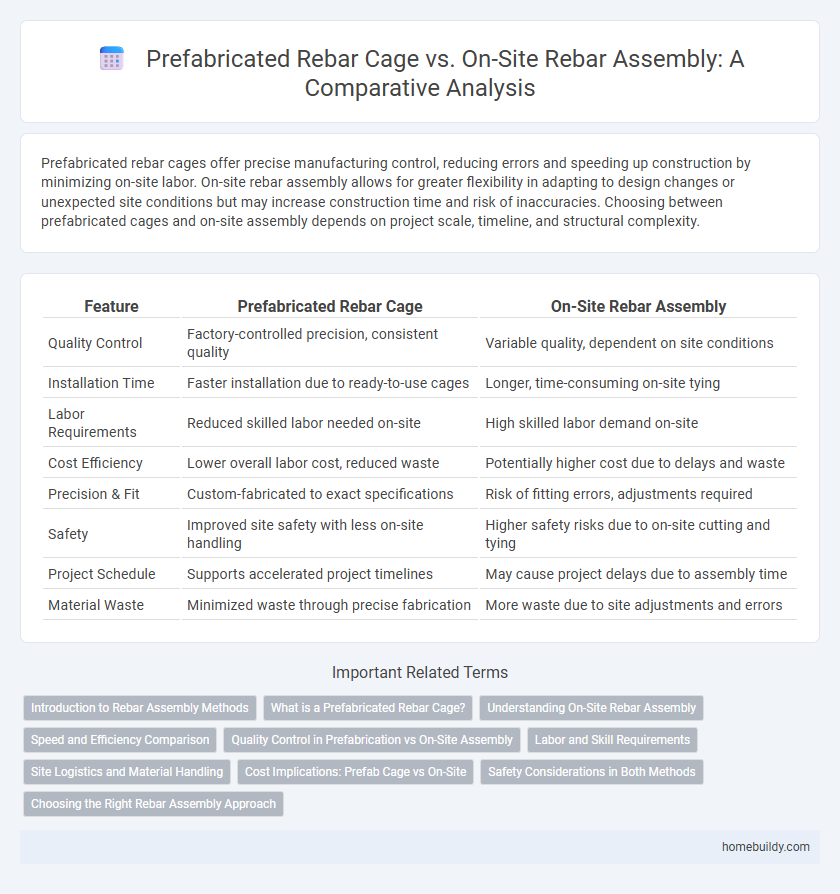Prefabricated rebar cages offer precise manufacturing control, reducing errors and speeding up construction by minimizing on-site labor. On-site rebar assembly allows for greater flexibility in adapting to design changes or unexpected site conditions but may increase construction time and risk of inaccuracies. Choosing between prefabricated cages and on-site assembly depends on project scale, timeline, and structural complexity.
Table of Comparison
| Feature | Prefabricated Rebar Cage | On-Site Rebar Assembly |
|---|---|---|
| Quality Control | Factory-controlled precision, consistent quality | Variable quality, dependent on site conditions |
| Installation Time | Faster installation due to ready-to-use cages | Longer, time-consuming on-site tying |
| Labor Requirements | Reduced skilled labor needed on-site | High skilled labor demand on-site |
| Cost Efficiency | Lower overall labor cost, reduced waste | Potentially higher cost due to delays and waste |
| Precision & Fit | Custom-fabricated to exact specifications | Risk of fitting errors, adjustments required |
| Safety | Improved site safety with less on-site handling | Higher safety risks due to on-site cutting and tying |
| Project Schedule | Supports accelerated project timelines | May cause project delays due to assembly time |
| Material Waste | Minimized waste through precise fabrication | More waste due to site adjustments and errors |
Introduction to Rebar Assembly Methods
Prefabricated rebar cages offer precise factory-controlled conditions, enhancing quality and reducing site labor and assembly time. On-site rebar assembly allows flexibility for adjustments during construction but can increase labor costs and potential for errors. Both methods are essential in structural reinforcement, chosen based on project scale, timeline, and complexity.
What is a Prefabricated Rebar Cage?
A prefabricated rebar cage is a precisely engineered reinforcement framework assembled in a controlled factory environment before being transported to the construction site. It ensures consistent quality, reduces labor costs, and shortens construction timelines by minimizing on-site adjustments. Prefabricated cages are commonly used in concrete columns, beams, and foundations for enhanced structural integrity.
Understanding On-Site Rebar Assembly
On-site rebar assembly involves the manual cutting, bending, and tying of individual steel bars directly at the construction site, allowing for customization to specific project requirements and immediate adjustments. This approach ensures flexibility in complex structural designs but often requires skilled labor and can lead to longer installation times compared to prefabricated rebar cages. Proper on-site quality control and precise measurements are critical to maintain structural integrity and meet engineering specifications.
Speed and Efficiency Comparison
Prefabricated rebar cages significantly enhance construction speed by reducing on-site labor and assembly time, allowing for quicker concrete pouring. On-site rebar assembly often requires more manual work and coordination, leading to slower progress and higher chances of errors or misalignments. Utilizing prefabricated cages improves overall project efficiency by streamlining workflow and minimizing downtime.
Quality Control in Prefabrication vs On-Site Assembly
Prefabricated rebar cages offer superior quality control through factory-controlled environments, precise automated cutting, and welding processes that minimize human error and inconsistencies. On-site rebar assembly often faces challenges related to weather, worker skill variability, and spatial constraints, increasing the risk of misalignments and defects. Ensuring consistent quality in prefabricated cages enhances structural integrity and reduces rework costs compared to the variability typical of on-site assemblies.
Labor and Skill Requirements
Prefabricated rebar cages reduce labor intensity and minimize the need for highly skilled workers by delivering ready-to-install reinforcement units, streamlining construction timelines. On-site rebar assembly demands skilled labor for precise cutting, bending, and tying, increasing labor hours and the potential for human error. Utilizing prefabricated cages enhances productivity while maintaining consistent quality, making it a cost-effective solution compared to traditional on-site rebar assembly.
Site Logistics and Material Handling
Prefabricated rebar cages significantly reduce site congestion and enhance material handling efficiency by delivering ready-to-install units, minimizing the need for extensive on-site storage and cutting down labor hours. On-site rebar assembly demands substantial workspace for sorting, cutting, and tying bars, often complicating site logistics and increasing material handling risks. Efficient coordination of prefabricated cages streamlines construction schedules and improves safety by limiting heavy rebar movements in confined areas.
Cost Implications: Prefab Cage vs On-Site
Prefabricated rebar cages typically reduce labor costs and minimize material waste compared to on-site rebar assembly, leading to overall lower project expenses. Factory-controlled environments enable precise bending and welding, decreasing errors and rework, which further optimizes budget adherence. On-site assembly often incurs higher labor rates and longer installation times, increasing direct and indirect costs associated with construction delays.
Safety Considerations in Both Methods
Prefabricated rebar cages significantly enhance safety by minimizing on-site handling and reducing exposure to hazards such as sharp edges and heavy lifting. On-site rebar assembly involves greater risk of injuries due to manual bending, tying, and positioning activities conducted at varying heights and confined spaces. Implementing strict safety protocols and using personal protective equipment (PPE) are critical for mitigating risks in both prefabricated and on-site rebar processes.
Choosing the Right Rebar Assembly Approach
Prefabricated rebar cages offer enhanced precision and consistent quality due to factory-controlled conditions, reducing onsite labor and minimizing construction delays. On-site rebar assembly provides flexibility for custom adjustments and complex designs, accommodating last-minute changes and project-specific requirements. Selecting the right approach depends on project size, complexity, available labor expertise, and timeline constraints to optimize structural integrity and cost-efficiency.
Prefabricated Rebar Cage vs On-Site Rebar Assembly Infographic

 homebuildy.com
homebuildy.com